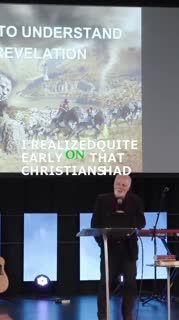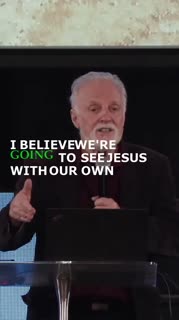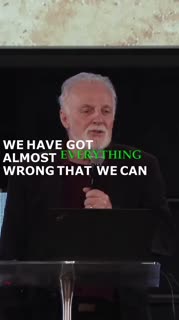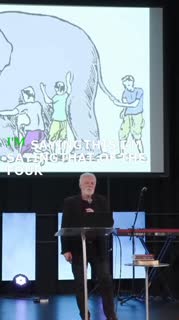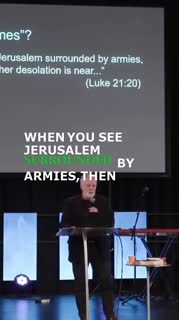Exploring Revelation: Diverse Interpretations and Core Truths
Summary
Taking a deep breath, I reflect on the journey that has brought us here today, a journey that began for me in 1973 when I first encountered the profound truths of the Bible. My exploration of end-time prophecy started with a study of Daniel chapter 2, which shook my atheistic beliefs and led me to Christ. Over the years, I've learned that interpretations of prophecy can vary widely, as evidenced by my experiences with Barry Smith and others who had differing views on the ten toes of Daniel's statue. This diversity of thought freed me to explore the scriptures with an open mind, focusing on the core truths that Jesus came to die for our sins and will return to judge the world.
In our exploration of Revelation, we must approach the text with the mindset of the Bereans, who eagerly received the word and examined the scriptures daily. This noble-mindedness is crucial as we navigate the complex imagery and symbolism of Revelation. The book is not a closed mystery but an open letter to the early church, filled with metaphors and symbols that were understood by its original audience. Our task is to discern what these symbols meant to them and how they apply to us today.
The trumpets of Revelation, often seen as divine judgments, can also be understood as alarms warning us of the consequences of our actions on the environment. The devastation we witness—pollution, deforestation, and the loss of marine life—are not acts of God but the result of human negligence. These are signs of the times, urging us to recognize the nearness of Christ's return.
As we consider the various interpretations of Revelation—preterist, historicist, futurist, and idealist—we find that each holds a piece of the truth. The whole of the elephant approach reminds us that no single perspective captures the entirety of God's plan. Instead, we must seek to understand the metaphors and symbols in their historical and cultural context, allowing them to illuminate our understanding of God's unfolding story.
Key Takeaways:
1. Diverse Interpretations and Core Truths: The journey through prophecy reveals diverse interpretations, yet the core truths remain: Jesus came to die for our sins and will return to judge the world. This understanding allows us to explore scripture with an open mind, focusing on the essentials of faith. [18:06]
2. The Berean Approach: Like the Bereans, we must receive the word with eagerness and examine the scriptures daily. This noble-mindedness helps us navigate the complex imagery of Revelation, discerning its meaning for the early church and its application for us today. [30:32]
3. Environmental Alarms as Signs: The trumpets of Revelation can be seen as alarms warning us of environmental destruction. These are not divine punishments but consequences of human actions, urging us to recognize the signs of the times and the nearness of Christ's return. [44:19]
4. Understanding Metaphors and Symbols: Revelation's metaphors and symbols were understood by its original audience. Our task is to discern their historical and cultural context, allowing them to illuminate our understanding of God's unfolding story. [41:05]
5. The Whole of the Elephant Approach: Each interpretation of Revelation holds a piece of the truth. By considering the preterist, historicist, futurist, and idealist views, we gain a fuller understanding of God's plan, recognizing that no single perspective captures the entirety of His story. [36:37]
Youtube Chapters:
[0:00] - Welcome
[15:21] - Personal Journey to Faith
[16:22] - Diverse Interpretations of Prophecy
[17:21] - Core Truths of Jesus' Mission
[18:06] - The Berean Approach
[19:32] - Understanding Revelation's Imagery
[20:40] - The Role of Metaphors
[21:54] - Environmental Alarms as Signs
[23:39] - Misinterpretations and Church History
[24:22] - Contextual Understanding of Scripture
[25:13] - Historical Context of Revelation
[26:51] - Artistic Misrepresentations
[27:58] - The Whole of the Elephant Approach
[29:30] - The Call to Be Like the Bereans
[30:32] - Examining the Scriptures Daily
Study Guide
### Bible Study Discussion Guide
#### Bible Reading
1. Acts 17:11 - "Now the Berean Jews were of more noble character than those in Thessalonica, for they received the message with great eagerness and examined the Scriptures every day to see if what Paul said was true."
2. Revelation 8:10-11 - "The third angel sounded his trumpet, and a great star, blazing like a torch, fell from the sky on a third of the rivers and on the springs of water—the name of the star is Wormwood. A third of the waters turned bitter, and many people died from the waters that had become bitter."
3. Daniel 2:31-35 - "Your Majesty looked, and there before you stood a large statue—an enormous, dazzling statue, awesome in appearance. The head of the statue was made of pure gold, its chest and arms of silver, its belly and thighs of bronze, its legs of iron, its feet partly of iron and partly of baked clay."
#### Observation Questions
1. What was the significance of the Bereans' approach to Scripture, and how did it differ from the Thessalonians? [29:30]
2. How does the imagery of the trumpets in Revelation relate to environmental issues mentioned in the sermon? [44:19]
3. What was the initial impact of Daniel's prophecy on the speaker's journey to faith? [15:21]
4. How does the speaker describe the diversity of interpretations regarding the ten toes of Daniel's statue? [16:22]
#### Interpretation Questions
1. How does the Berean approach to Scripture encourage a deeper understanding of biblical texts, and why is it important for interpreting Revelation? [30:32]
2. In what ways can the environmental alarms described in Revelation be seen as a call to action for believers today? [44:19]
3. How does the speaker's personal journey with prophecy highlight the importance of focusing on core truths in Christianity? [18:06]
4. What does the "Whole of the Elephant" approach teach us about understanding complex biblical prophecies? [36:37]
#### Application Questions
1. How can you incorporate the Berean approach into your daily Bible study to ensure a more thorough understanding of Scripture? [30:32]
2. Reflect on your personal impact on the environment. What steps can you take to align your actions with the biblical call to stewardship? [44:19]
3. Consider the diverse interpretations of prophecy. How can you maintain focus on the core truths of Christianity in your spiritual journey? [18:06]
4. How can understanding the historical and cultural context of biblical symbols enhance your interpretation of Revelation? [41:05]
5. Identify a current environmental issue that resonates with the trumpet imagery in Revelation. How can you raise awareness or take action in your community? [44:19]
6. Reflect on a time when you encountered differing interpretations of a biblical text. How did you navigate these differences, and what did you learn from the experience? [36:37]
7. How can you apply the "Whole of the Elephant" approach to other areas of your life where multiple perspectives exist? [36:37]
Devotional
Sure, here is the 5-day devotional based on the key takeaways from the sermon summary:
---
Day 1: Embracing Diverse Interpretations with Core Truths
The journey through biblical prophecy reveals a tapestry of diverse interpretations, each offering a unique perspective on the unfolding of God's plan. While interpretations may vary, the core truths remain steadfast: Jesus came to die for our sins and will return to judge the world. This understanding invites us to explore scripture with an open mind, focusing on the essentials of faith. By embracing the diversity of thought, we are freed to delve deeper into the scriptures, allowing the Holy Spirit to guide us in discerning the truths that are central to our faith. [18:06]
"For we know in part and we prophesy in part, but when the perfect comes, the partial will pass away." (1 Corinthians 13:9-10, ESV)
Reflection: Consider a time when you encountered a different interpretation of a biblical passage. How did it challenge or enrich your understanding of your faith? How can you remain open to diverse perspectives while holding onto core truths?
---
Day 2: The Berean Approach to Scripture
The Bereans were commended for their noble-mindedness, receiving the word with eagerness and examining the scriptures daily. This approach is crucial as we navigate the complex imagery and symbolism found in books like Revelation. By adopting the Berean mindset, we are encouraged to engage with scripture actively, seeking to understand its meaning for the early church and its application for us today. This diligent study fosters a deeper relationship with God, as we allow His word to illuminate our path and guide our lives. [30:32]
"Now these Jews were more noble than those in Thessalonica; they received the word with all eagerness, examining the Scriptures daily to see if these things were so." (Acts 17:11, ESV)
Reflection: How can you incorporate the Berean approach into your daily routine? What steps can you take to ensure that you are eagerly receiving and examining the scriptures each day?
---
Day 3: Recognizing Environmental Alarms as Signs
The trumpets of Revelation, often interpreted as divine judgments, can also be seen as alarms warning us of the consequences of our actions on the environment. The devastation we witness—pollution, deforestation, and the loss of marine life—are not acts of God but the result of human negligence. These signs of the times urge us to recognize the nearness of Christ's return and our responsibility to care for His creation. By acknowledging our role in environmental destruction, we are called to take action, stewarding the earth with the care and respect it deserves. [44:19]
"The earth lies defiled under its inhabitants; for they have transgressed the laws, violated the statutes, broken the everlasting covenant." (Isaiah 24:5, ESV)
Reflection: What practical steps can you take today to reduce your environmental impact? How can you become more mindful of the ways your actions affect God's creation?
---
Day 4: Understanding Revelation's Metaphors and Symbols
Revelation is filled with metaphors and symbols that were understood by its original audience. Our task is to discern their historical and cultural context, allowing them to illuminate our understanding of God's unfolding story. By studying these symbols, we gain insight into the message of hope and redemption that Revelation offers. This understanding encourages us to look beyond the surface, seeking the deeper truths that God is revealing through His word. [41:05]
"To you it has been given to know the secrets of the kingdom of heaven, but to them it has not been given." (Matthew 13:11, ESV)
Reflection: Choose a symbol or metaphor from Revelation and research its historical and cultural context. How does this understanding change your perception of the passage and its message for today?
---
Day 5: The Whole of the Elephant Approach
Each interpretation of Revelation holds a piece of the truth, much like the story of the blind men and the elephant. By considering the preterist, historicist, futurist, and idealist views, we gain a fuller understanding of God's plan, recognizing that no single perspective captures the entirety of His story. This approach encourages humility and openness, as we acknowledge that our understanding is limited and seek to learn from others. By embracing the whole of the elephant, we are better equipped to grasp the richness and depth of God's revelation. [36:37]
"For now we see in a mirror dimly, but then face to face. Now I know in part; then I shall know fully, even as I have been fully known." (1 Corinthians 13:12, ESV)
Reflection: Reflect on a time when you encountered multiple interpretations of a biblical passage. How did each perspective contribute to your understanding? How can you cultivate a spirit of humility and openness in your study of scripture?
Quotes
1. "I realized quite early on that Christians had different ideas on this stuff. But that freed me up, to be honest, because I thought, oh, okay, so it's not that watertight. And who knows? But I thought, well, Barry's the guy I know, and I love him. He's a wonderful man and very funny as well. So he was very entertaining as well as incredibly enthusiastic for Jesus." [16:22] (24 seconds)
2. "Jesus came the first time to die on the cross for my sins, and he's come back the second time to judge the world. He said, do you believe that? I said, absolutely. He said, in that case, there's no problem between us. Because he said, they're the only two things I know for sure. Everything else is up for grabs." [18:06] (18 seconds)
3. "I believe we're going to see Jesus with our own eyes. I'm saying he's going to be coming back in the next 15, 20 years maximum. And I'll give you some reasons why I think that. So I don't have a date, but I do have a season." [18:42] (12 seconds)
4. "We have got almost everything wrong that we can get wrong. Now, I don't blame anybody for it because the church has got everything wrong for hundreds of years. That's kind of our tradition. Whatever we can get wrong, the church does it, right? We do it." [23:39] (13 seconds)
5. "My heart is to say, right, let's get rid of the nonsense. What does the text say? And what does the text say to the people it's written to?" [24:22] (10 seconds)
6. "You and I need to do what the Bereans did. Now, I love this verse. It's burned on my heart. Acts 17, 11. The Bereans, these were more noble -minded than those in Thessalonica. Because in Thessalonica, the Jews had turned on Paul and Silas when they came to preach the gospel. But the Jews in Berea were noble -minded." [29:30] (20 seconds)
7. "I'm saying this. I'm saying that of the four views, all of them have got something right. All of them have got something right. The preterist, for example, some of it was over by 70 AD." [37:26] (14 seconds)
8. "The trumpets are not God saying, I'm going to do terrible things to you. It was God saying, when you've done terrible things to your environment, that's an alarm going off." [43:33] (12 seconds)
9. "When you see Jerusalem surrounded by armies, then recognize that her desolation is near. A sign of the times by definition is when you see something, recognize the timing." [57:12] (17 seconds)
10. "I'm saying this generation we're living in right now is going to see it all. Now I've got a list in a minute. I'm going to go through some of these. There's 22 signs of the times. Of the 22 signs of the times, 10 have already happened." [01:04:42] (13 seconds)
